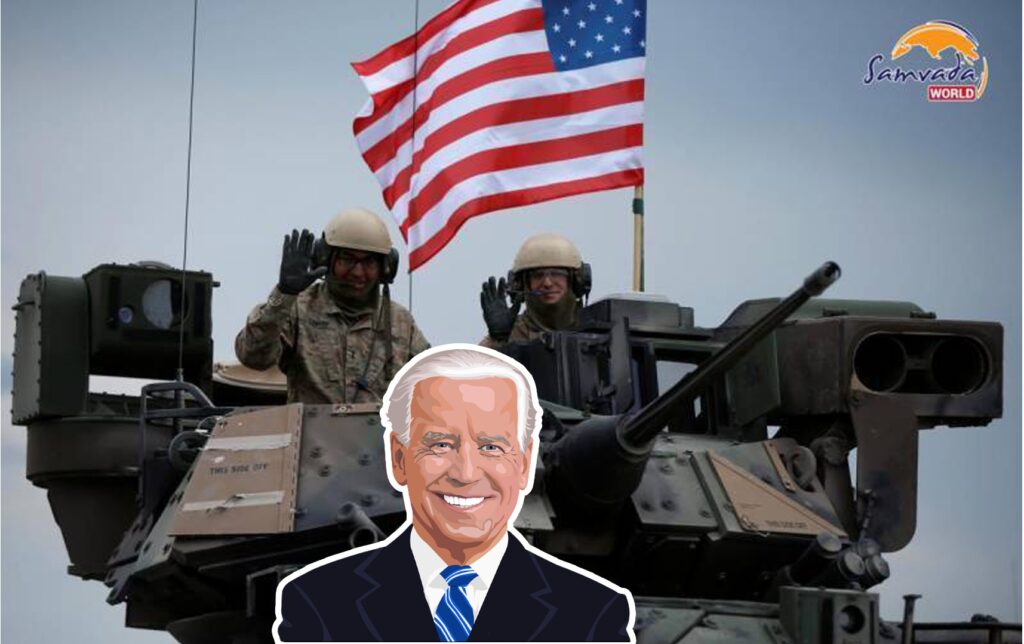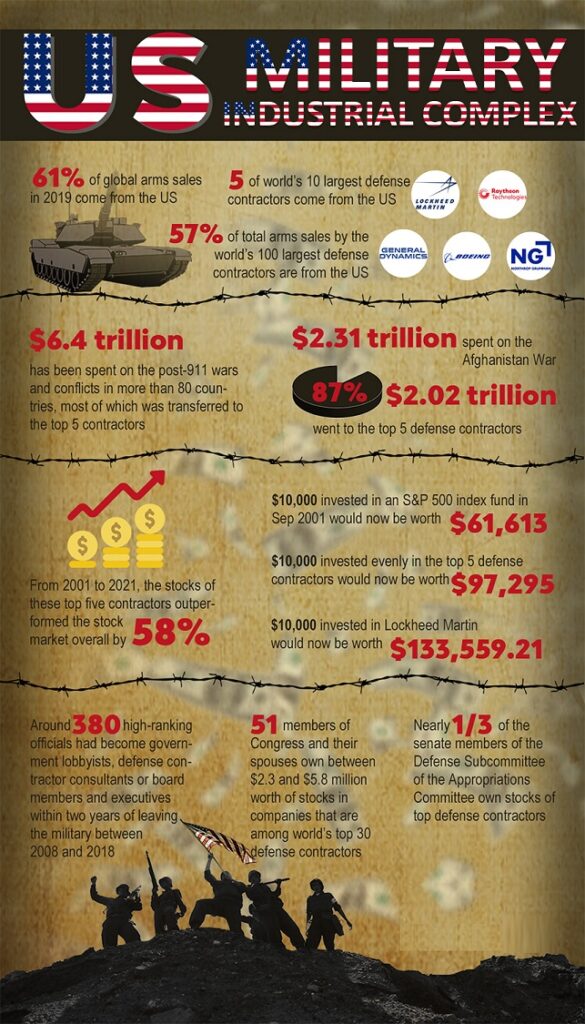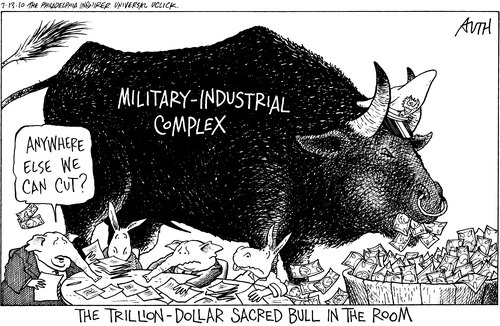
- The American Military Industrial Complex (AMIC) is a perceived informal alliance between a portion of the nation’s scientific and technological community, its defence establishment and certain sectors of the country’s military base.
- In 2021 the defence Budget of the US has gone up to $778 Billion, which means the United States spends more on defence than the next 11 countries combined amongst the highest defence spenders of the world.
- The political arrangement of the AMIC is very different from the way the competitive markets work, as it has important consequences on the country’s national security and foreign policy decision making.
- This fundamental lack of basic accounting processes and controls, means that the Pentagon is unable to keep track of its financial resources and expenditure in any meaningful way.
- Since 1997 the government accountability office has been legally required to audit the financial statements of the federal agencies. Despite this requirement, it has been unable to audit the Department of defence(DoD), because the DoD has been unable to provide accurate and credible financial documents.
- As an expansion of its footprint in Europe, the USA through its NATO alliances with Eastern European countries which were former Soviet Republics, has taken up its eastward march which has irked Russia in several ways.
After the end of the Second World War, which was formidably won by the Allied powers led by the USA, a new world order was created. This led to the rise of the superpowers USSR and the USA. As the world entered the cold war era, an international arms race picked up at a rocketing pace, where the superpowers of the world developed and acquired the latest weapons, with cutting edge technology. The USA being a hegemonic power in the western democratic world became a leader in military R&D and technology. With this, the national security strategy of the Americans gained new and ambitious dimensions. In 1947 President Henry Truman came up with a foreign policy and national security objectives and articulated them extensively in the US congress. It later came to be known as Truman’s doctrine.
The key elements of the doctrine were:
- Active opposition to the Soviet Union worldwide.
- The USA had a much bigger and stronger role than Franklin D Roosevelt had ever imagined.
- Permanent global US military and political activity. Even though the basis of this doctrine was augmented for the cold war era, the third element of global military and political involvement is actively pursued by the USA even today. In 1948 Truman’s doctrine was followed by the Marshall Plan.
- George G. Marshall proposed a massive US Aid plan to help Europe in the war recovery.
- Marshall Plan swung into action and pumped $12 Billion into Europe.
- This was a major part of US efforts to contain the communist expansion.
- Marshall plan started Western Europe on to the road of economic integration.
Therefore we can easily say the USA, through its Marshall Plan, became the de facto guardian of Europe, especially the Western Europe. As an expansion of its footprint in Europe, the USA through its NATO alliances with Latvia, Lithuania, Poland and some other Eastern European countries which were former Soviet Republics, has taken up its eastward march which has irked Russia in several ways.
But USA’s National security revolves around several other key elements which are more or less globalist in nature.
- The self appointed task of protecting freedoms and democratic systems across the world.
- Protection of European Interests and safeguarding the ethos of Western Civilization.
- Pursuing economic hegemony and sanctions as a policy measure.
- Protection of regional spillovers and diffusion of regional conflicts along with sharing of security responsibilities with regional powers, to reduce the direct US military manpower burden with enhancing the export of US defence technology and weapons.
- Re-invigorating the energy industry and modernizing the nuclear triad in pursuit of nuclear deterrence.
- Europeanization and westernization of the former Soviet Republics.
- Humanitarian intervention across the world when suited for its own national interests.
By engaging in international conflicts and wars, the US has become the world’s policeman and due it’s sheer economic and military might several countries are compelled to co-operate or stay neutral when the US wants to cohesively pursue its national interests. Its interventions in the Korean War (1950-53), Vietnam War (1965-73) Chile (1975), Panama (1989), Gulf war (1990-91), Iraq (2003) Afghanistan (2001-2021) demonstrates the fact that the USA is constantly mired in wars and conflicts across the world. The dark secret behind its active global lethal military activity is its mammoth war machine and the deep web of its military industrial complex.
Analyzing America’s Military Industrial Complex
The American Military Industrial Complex (AMIC) is a perceived informal alliance between a portion of the nation’s scientific and technological community, its defence establishment and certain sectors of the country’s military base. In other words AMIC is the relationship between military leaders, government legislators, bureaucrats and private contractors, all of whom have a stake in the national defence.
During the early years of Independent USA, and the early governments of the 18th and 19th century, it didn’t even have a standing army. In fact several founding fathers and the early presidents of America considered standing armies as a threat. The American declaration of independence stated the reason for separating from England was the presence of a standing army. It shows that they were so averse and cautious of having a military force in peace times. The faint effort towards developing a AMIC was conceptualized in 1983.
AMIC is the relationship between military leaders, government legislators, bureaucrats and private contractors, all of whom have a stake in the national defence.
The Abraham Lincoln administration passed a bill in the US congress that would put a new scientific community at the service of the Federal Government to Investigate, experiment and report on any subject when requested by a federal department, which was enacted and established as the National Academy of Sciences. But it’s important to note that any institution, organization or a consortium of Scientists and engineers who were requested to work for the Federal Government on defence/military purposes during the war time, were discontinued during the peace time and they continued their scientific and research activities in the civilian domains. This system continued till the Second World War period.

In 1941 during the Franklin D Roosevelt administration a temporary wartime agency, the Office of Scientific Research and Development (OSRD) was established. OSRD mobilized the country’s academic, technological and industrial resources in the support of the war effort, and in doing so, profoundly transformed the linkages between the science and engineering, industry and the government. Although the OSRD was disbanded on December 31, 1947 and its remaining functions were transferred to the National Military Establishment, the organization had proved to have made a deep impact on structuralizing the basis of AMIC in several ways. This led to the establishment of permanent ties between the military and scientific research which became permanently entwined, which continues in a crony capitalist network and format till date.
Office of Scientific Research and Development (OSRD) mobilized the country’s academic, technological and industrial resources in the support of the war effort, and in doing so, profoundly transformed the linkages between the science and engineering, industry and the government.
In 1961 President Dwight D. Eisenhower made a critical statement during his farewell speech, he said “the total influence (referring to AMIC), economic, political, even spiritual is felt in every city, every state house, every office of the Federal government. We have been compelled to create a permanent armaments Industry of vast proportions. In the councils of the government, we must guard against the acquisition of unwarranted influence, whether sought or unsought by the military industrial complex.” He goes on to say, “the potential rise for the disastrous rise of misplaced powers exists, and will persist, we must never endanger our liberties or democratic processes”. Almost everything that Eisenhower predicted and feared has come true in the contemporary times of American experience. In fact the defence Industry has grown bigger and mightier than Eisenhower ever imagined it to be.
The important components of the Military Industrial Complex are:
- Arms Manufacturers and defence corporations
- Congressional members
- Defence Bureaucracy
- Pentagon Establishment and the power elites
Post the cold war, once the soviet threat was over, the expectation was to retreat back to normalcy and take on the task of de-hyphenation of global military activity. But post cold war activity has shown that Americans at the behest of the AMIC continued to stay whether or not they had a major enemy to warrant. The military establishment had become concrete and permanent by the late 1990’s. High ranking military leaders often look forward to high paying jobs with defence contractors after their public careers are over. This is the reason why the US military budget always goes up.
In 2021 the defence Budget of the US has gone up to $778 Billion, which means the United States spends more on defence than the next 11 countries combined amongst the highest defence spenders of the world. Military money funds an immense ecosystem of which is knowingly or unknowingly dedicated to the continuation of the same system. The system is so crony that a small number of companies who have a close relationship with government officials and possess specialized knowledge of the process tend to win most of the defence contracts and these contracts are well known to be highly lucrative in nature. The defence contractors that provide the government with military equipment and services naturally would want to leech up as much money as possible from this mammoth defence budget. They spend a significant amount of money to gain access to politicians and bureaucrats in order to influence their decisions. The strong ties defence contractors develop with politicians and bureaucrats lead to what is known as the revolving door, where people hop from jobs in the private firms to jobs in the government and vice versa.
The post cold war activity has shown that Americans at the behest of the AMIC continued to stay whether or not they had a major enemy to warrant. The military establishment had become concrete and permanent by the late 1990’s.
This dynamic only tightens the relationship that private firms have with the government and allows them to take advantage of these connections, leading to two important implications.
1) Crucial decisions about the war are not made by dispassionate politicians comparing costs and benefits of the military action: Both government and private businesses are active participants in the defence sector and each attempt to influence and shape the behaviors of the other. Lets say when you are manufacturing and profiting from the military equipment you stand to benefit greatly from an interventionist foreign policy. If you persuade policy makers, many of whom are your friends and former colleagues, to pursue military action, it’s more business for you. The travesty of this can result in wars with military personnel shipped to distant territories to fight and die without making the nation any safer.

2) The government’s defence budget is fought over by many firms looking to secure military contracts: let’s imagine that I’m a manufacturer of tanks, it is in my best interest to try and get the government to spend as much of its defence dollars as possible on tanks, even if this is obviously a poor defence strategy. Private defence firms seek to grab as much defence budget as possible, and as quickly as possible with little or no regard for broader external costs of their behavior. Yet their lobbying efforts still shape the decisions of the government. The amount spent by defence companies is quite staggering. In 2020 leading the lobby circuit was Lockheed Martin which spent over $12.8 million, followed by Boeing $12.6 million, Northcorp Grumman $ 11.7 million, General Dynamics $ 10.7 Million, Raytheon Technologies $7.5 million and the list goes on. Probably this is the reason why the US air force is forced to buy F35 fighter jets manufactured by Lockheed Martin even though there are several technical issues and cost concerns that are repeatedly raised by the US air force. This means that rather than only considering the public interests, the Military decisions are shaped by special interests in the private sector, which can have disastrous consequences.
No wonder why people keep asking the question as to why the Americans have more than 800 military bases across the world that include military compounds, airstrips, drone bases, intelligence resource units etc. It’s quite shocking to learn the fact that the US is estimated to have spent $4.79 trillion in the Iraq, Syria and Afghanistan wars. It is not surprising that the USA stands as the world’s largest defence exporter with $138.2 Billion exports in the fiscal year 2021.
One needs to understand that the political arrangement of the AMIC is very different from the way the competitive markets work, as it has important consequences on the country’s national security and foreign policy decision making. In the competitive markets, the profit and loss feedback provide continual feedback as to whether companies are using their resources effectively or not and firms face real competition. The result is that resources tend to be used where they create market value. But for the military contractors, profit and losses are determined not by the market, but by a firm’s ability to navigate in political circles with the power elite. Decisions about where the resources will go are made by bureaucrats and not through market competitiveness. This means that there is no way to ensure that resources used in the defence industry are being used where they are valued the most. There is little accountability for wasteful spending.
Since 1997 the government accountability office has been legally required to audit the financial statements of the federal agencies. Despite this requirement, it has been unable to audit the Department of defence(DoD), because the DoD has been unable to provide accurate and credible financial documents. This fundamental lack of basic accounting processes and controls, means that the Pentagon is unable to keep track of its financial resources and expenditure in any meaningful way. The sheer size and complexity of the AMIC coupled with its absurdly lofty foreign policy goals through oversight and accountability are virtually impossible.
The Idea that US military leadership provides an indispensable stability of the globe is now a fixture of their global strategy and foreign policy. This leaves us with a very pertinent question, ‘do Americans focus on its national security or their Congressional job security’?
The only real solution would be to drastically reduce the size and scope of the military and related government agencies, which would remove many of the incentives for the special interests to influence the US foreign policy and defence spending.
An entire generation of Americans who have grown up and reached adulthood during the time of the post 9/11 wars, are committed to principles of tolerance and trade with mutual and peaceful cultural exchange. They are deeply skeptical of the military as a preferred instrument of American foreign policy. But still the Idea that US military leadership provides an indispensable stability of the globe is now a fixture of their global strategy and foreign policy. This leaves us with a very pertinent question, ‘do Americans focus on its national security or their Congressional job security’?
References:
- Doyle, Richard B. “The U.S. National Security Strategy: Policy, Process, Problems.” Public Administration Review, vol. 67, no. 4, [American Society for Public Administration, Wiley], 2007, pp. 624–29, http://www.jstor.org/stable/4624613.
- Dunlap, Charles J. “The Military-Industrial Complex.” Daedalus, vol. 140, no. 3, The MIT Press, 2011, pp. 135–47, http://www.jstor.org/stable/23047354.
- Baack, Ben, and Edward Ray. “The Political Economy of the Origins of the Military-Industrial Complex in the United States.” The Journal of Economic History, vol. 45, no. 2, Cambridge University Press, 1985, pp. 369–75, http://www.jstor.org/stable/2121706.
- Bruce G. Brunton. “Institutional Origins of the Military-Industrial Complex.” Journal of Economic Issues, vol. 22, no. 2, Association for Evolutionary Economics, 1988, pp. 599–606, http://www.jstor.org/stable/4226018.
(The author has an MA in International Studies. Views expressed are author’s own)
Viswapramod is a PhD Scholar at the Department of International Studies and Political Science, Christ University, Bangalore. He has an MA in International Relations. Views expressed are the author’s own.

What a fantastic Read. The Author is demonstrating authority on the subject with data points.